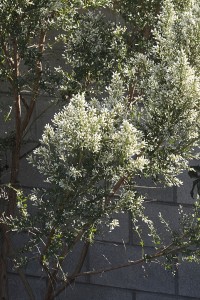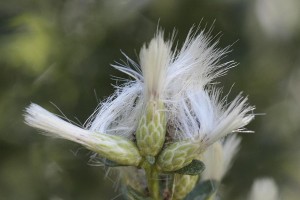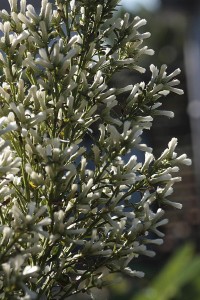Maybe three years ago I started some coyote bush from local seed. This species, Baccharis pilularis is a pretty easy plant to reproduce this way, pretty close to “just add water.” It produces plants that are either entirely male or entirely female in the kinds of flowers they produce, or “dioecious” in botany-speak. When you grow them out from seed you have a pretty even chance that a single plant will be male or female.
Each gender has its uses in the garden. The males are great if you want a fast-growing reliably green mound of foliage that keeps requires close to zero added water in a garden situation. Virtually all coyote cultivars are boys.
The females are also fast-growing reliably green mounds of foliage that keeps require close to zero added water in a garden situation. But unlike the males produce thick foliage-obscuring quantities of white seed heads in the late fall and early winter when most other plants aren’t quite so glamorous. They’re spectacular, but come with the down-side that the seeds can flit about and land all over, populating your garden with little coyote bushes. This is why most named cultivars in the nursery trade are males. The sole exception, which was pointed out to me by Barbara of Wild Suburbia, is Centennial, a believed hybrid of this species and B. sarothroides.
Some closeups of the seed heads…
I’ve waxed poetic about the hillsides shot with flashes of white like this one that you see at this time of year.
Now I guess I’m putting my money where my mouth is. How bad is it having a female coyote bush in the garden? I’m about to find out, and I’ll report back here. But I doubt it’ll be any worse than a few other plants in the garden that spread themselves about. And if a few plants find their way into the bleak rental next door where the only things the renters are growing in their dirt-patch of a garden are mastiffs and bulldogs, how can it be a bad thing?






Beautiful seedheads – good luck not being overwhelmed by seedlings, but I think well worth the risk.
The only seed producers that I simply can not stamp out are Nigella and Cerinthe. I tried and tried, then, with a shrug, decided “oh well, they’re pretty”. Who knows what this new devil-may-care attitude will bring. I love the idea of coyotes springing up next door, where they surely will be left to their own devices.
I agree, the girls are prettier. Then again, a friend of mine, a die-hard native plant enthusiast, had to take hers out because all the neighbors started to see them sprout up. So, maybe it’s not just how many seeds but how far they travel. Then again, those mastiffs probably appreciate a few more small trees to raise their leg against, so you’re doing everyone a favor.
(creepy neighbours?) That impression of hillsides with white flashes – is what I get from wild rosemary, kapokbossie for the fluffy seeds the birds use as nesting material. I have four teenaged plants, grown from cuttings by a friend.
How funny – I just wrote a post recently about telling the boys from the girls! Congrats on your little girl 🙂
Surely the bulldogs will enjoy the seedlings. Had a serious problem with Cercis occidentalis reseeding everywhere. When they started sprouting in my neighbor’s yards I had to do something. Good luck!
Janet, yes, a few too many of a plant I enjoy would be a pleasant enough problem to have to put up with…
Ricki, I haven’t grown either of your overenthusiastic garden guests, but neither of them is on the major California watchlists. I guess it’s a water thing. But hey, they’re pretty plants.
TM, we’ll see which plant wins the battle next door, invasive iceplant or coyote bush. I’m secretly pulling for one of them but I suspect the sea fig will smother all the little coyote seedlings…
Diana, the sight of seeds floating in the air against a dark background is a lovely thing to behold this time of year, and it sounds like you have your equivalent plants. Enjoy the show!
CM, I enjoyed your post very much. These being such attractive plants, I’m not surprised that two Californians were inspired to write something about them, particularly now, when they’re looking their best.
Hoov, I hadn’t heard of the Cercis being the problem you’ve experienced. It’s ended up on a short list of large plants for my garden but some other plant has always worked its way to the top of the list at plant-purchasing time. Thanks for the heads-up.
CM,
I really like the close up. It looks like a cartoon character, either a head with wacky hair and eyebrows or some kind of cartoon animal. We’ve had a few gardens where we let coyote brush volunteers stay. I don’t think it got crazy with seedlings; the traditional weeds were much worse. I just know that if you let the plant stay for too long it makes a mighty taproot that can be hard to get out. But I like to let the coyote brush stay. Cheers for planting it.
I found your site when i was searching for ways to collect coyote bush seeds. We made our front yard into a native garden and planted a bunch of coyotes. I want to start them in our greenhouse and transplant up on our back hill. I have a zillion seeds, Great blog and links! I’m up in Cbad.
Ryan, good to know about the tap root. We had the groundcover kind for ~15 years or so. Those plants didn’t have killer roots to deal with. Maybe gophers had something to do with it.
Enchanted, thanks for visiting, and for the nice comments. It sounds like you found out how to save the seeds successfully, and it looks like you’re going to have quite the coyotoe bush pack once you’re through! And, Carlsbad! It’s cool to hear from more folks in the county. I know we’ve got more than a few native plant enthusiasts down here. You’re doing good work.
Yes, but if all you have is a female, and there aren’t any males around …well, then, you’re probably safe.
Even if there are males lurking somewhere (like waiting for the right moment to knock on your front door to see if they can ask your coyote bush out)and Baccharis pilularis has a specific Seed Transfer Zone and the males aren’t in the same one as your female, then no big deal.
I have one in my garden, NDY (not dead yet), and I expect it to behave regardless of its sex, because any prospective suitors are a long way off.
I am always looking to expand my knowledge of plant propagation. I found the information to be thorough and easy to understand. The photos were also very helpful. Thank you for posting.
Coyote bush is the default first native plant invasive here in the San Francisco Bay Area, and in my opinion isn’t a good fit with gardens, and I think you’ll find this more like battling dandelions/fennel over time than a native to appreciate in your own garden. They pop up everywhere around here, even when it there isn’t one to be seen for 100’s of yards in sight.